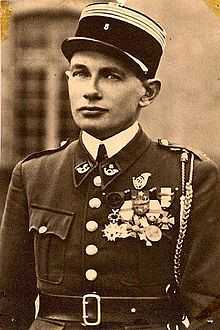Syria-Cilicia commemorative medal
| Syria-Cilicia commemorative medal | |
|---|---|
 | |
|
Awarded by | |
| Type | Campaign Medal |
| Eligibility | French nationals, soldiers under French flag |
| Awarded for | Middle Eastern campaigns between 11 November 1918 and 30 September 1926 |
| Clasps | "Levant" and "1925-Levant-1926" |
| Statistics | |
| Established | 18 July 1922 |
| Precedence | |
| Next (higher) | Médaille commémorative de la guerre 1914–1918 |
| Next (lower) | Dardanelles campaign medal |
|
Ribbon of the Syria-Cilicia commemorative medal | |


The Syria-Cilicia commemorative medal (French: "Médaille commémorative de Syrie-Cilicie") was a French military campaign medal bestowed for participation in the battles that erupted in the Middle East in the immediate aftermath of World War I between France and the local powers.
The initial campaigns began in January 1920, when the Arab Kingdom of Syria engaged French forces in what would be called the Franco-Syrian War. This campaign ended on 24 July 1920, when French troops entered Damascus abolishing the Arab Kingdom of Syria. Turkey took advantage of the situation by also engaging France in what is now called the Franco-Turkish War pitting the French Colonial Forces and French Armenian Legion against the Turkish forces known as the Kuva-yi Milliye. This campaign, running from May 1920 to October 1921 resulted in a partial French occupation of Turkish soil.
The uneasy peace was broken on 23 August 1925, when Sultan Pasha al-Atrash officially declared revolution against France, thus beginning the Great Syrian Revolt also called the Great Druze Revolt, which would take a few years to completely quell, but that still resulted in a French victory.
Award history
The Syria-Cilicia commemorative medal was instituted by the law of 18 July 1922[1] following a bill started by general de Castelnau, who was a member of the legislative assembly and president of the military Army Commission.[2]
A Vichy sponsored identical medal was produced during World War II to recognize engagements fought by its forces in the same area from 8 June to 12 July 1941, it was adorned with the clasp "LEVANT 1941". Most battles were between Vichy forces and Free French Forces, this was and still is a source of national pain for France. Consequently, a law of 12 April 1944 abolished this medal and the right to wear it.[2]
Award statute
The Syria-Cilicia commemorative medal was bestowed to soldiers and sailors, members of the Army of the Levant or of naval forces that operated off the coast of Syria-Cilicia, between 11 November 1918 and 20 October 1921; to members of the military having taken part in the operations carried out between 21 July 1925 and 30 September 1926; to civilian personnel of French nationality, fulfilling the same prerequisites as soldiers or sailors in earning this award.[2]
Prior to 1939, a series of decrees allowed for its bestowal after 30 September 1926 under very specific conditions. These awards to both civilian and military personnel on special assignment in Lebanon or Syria were very rare. When bestowed after 1926, the medal is worn without a clasp.[2]
Award description
The Syria-Cilicia commemorative medal is a 30mm in diameter circular medal struck from bronze. The obverse bears the relief image of the "warrior republic" in the form of the left profile of a helmeted woman's bust, the helmet being adorned by a crown of oak leaves. On either side, the relief inscription along the circumference "RÉPUBLIQUE FRANÇAISE" ("French Republic").[2]
The reverse, representing both the army and navy, bears the relief images of an infantry rifle crossed with a naval anchor below two military banners and lances surmounted by the relief inscription "LEVANT". On some variants, the relief inscription "HONNEUR ET PATRIE - SYRIE-CILICIE" ("Honour and Country - Syria Cilicia") or only "HONNEUR ET PATRIE" can be found on one of the banners. In the background, sand dunes, the wall of a Kasbah and palm trees.[2]
The medal hangs from a ribbon through a ring passing through the medal's suspension loop. The ring is adorned by a 24 mm in diameter bronze laurel wreath and half crescent. The white silk moiré ribbon is 37 mm wide with 3 mm high blue horizontal stripes 3 mm equidistant.[2]
Two gilt clasps with oriental ornamentation can be worn on the ribbon. The first bearing the inscription "LEVANT" for participations in the operations between 11 November 1918 and 20 October 1921. The second clasp bearing the relief inscription "1925-Levant-1926" for operations against the Druze. Both clasps can be earned and worn simultaneously on the ribbon.[2]
Notable recipients (partial list)
- General André Hartemann
- General Raoul Salan
- Captain Tounsi Tayeb
- Father Jules Chaperon
- General Georges Journois
- General Georges Catroux
- General Jean-Édouard Verneau
- General Jacques-Théodore Saconney
- General André-Gaston Prételat
- General Raoul Magrin-Vernerey
- General Mariano Goybet
- Colonel René Génin
See also
- French Mandate for Syria and the Lebanon
- French mandate of Lebanon
References
Sources
| ||||||||||||||||||||||||||||||||||||